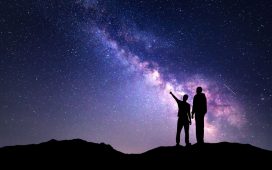With Christmas just two days away now, children around the world will eagerly be keeping their eyes to the skies in the hopes of seeing Santa on his travels.
Parents will be delighted to hear that ‘Santa’ – in the form of the International Space Station (ISS) – will be visible from the UK this Christmas Eve.
NASA says the spacecraft will be the ‘third brightest object in the sky and easy to spot if you know when to look up’.
And, while it’s not the man in red, the ISS will make a good alternative for the big and small kids who will be looking out for him.
‘Visible to the naked eye, the space station looks like a fast-moving plane, only flies much higher, and travels thousands of miles an hour faster!’ NASA said.

For parents wanting to surprise their kids with a festive surprise, the passing of the International Space Station can make quite a convincing stand-in for Santa’s sleigh

The ISS (aka Santa) will have a very clear pass over the UK on Christmas Eve and will be clearly visible overhead just before dawn
| Date and Time | Visible | Max Height | Appears | Disappears |
|---|---|---|---|---|
| Dec 23, 5:55AM | 4 mins | 65° | 52° above SW | 10° above E |
| Dec 24, 5:10AM | 2 mins | 27° | 27° above E | 10° above E |
| Dec 24, 6:42AM | 6 min | 86° | 18° above W | 10° above E |
| Dec 25, 5:56AM | 4 min | 89° | 68° above W | 10° above E |
| Dec 26, 5:11AM | 2 min | 26° | 26° above E | 10° above E |
| Dec 26, 6:44AM | 6 min | 89° | 21° above W | 10° above E |
| Dec 27, 5:57AM | 4 min | 86° | 68° above WNW | 10° above E |
| Dec 28, 5:11AM | 2 min | 26° | 26° above E | 10° above E |
| Dec 28, 6:44AM | 5 min | 66° | 21° above W | 10° above ESE |
The ISS will make two passes of the UK in the early morning of Christmas Eve.
The space station will first briefly appear at 5:10am GMT on Sunday morning and be visible for about two minutes.
To see the first pass, look towards the East at 27° above the horizon.
For reference, one fist held out at arm’s-length is usually about 10° so you can use this as a guide to help find the ISS starting point.
It will then appear again at 6:42am GMT when it will be visible for a full six minutes.
This time the ISS will appear 18° above the West and follow a long arc until it disappears in the East.
As well as being a little bit easier to wake up for, this second pass will also offer a better view of the station as it should be higher than most buildings.
If you’ve been woken up early on Christmas Day, or are just coming home from a particularly good Christmas Eve Party, there will be another chance to spot the ISS the next day.

To keep the magic of Santa alive this year, keep an eye out for the bright light of the ISS as it passes overhead
You will be able to see ‘Santa heading back to the North Pole’ at 5:56am GMT for four minutes.
To watch this festive treat, look towards the West where the ISS should appear 68° above the horizon for four minutes before passing out of view in the East.
According to NASA, the best viewing times for the ISS are always just before morning or after sunset.
It explained: ‘This is the optimum viewing period as the sun reflects off the space station and contrasts against the darker sky.’
What else to see in the sky this Christmas
If you can’t quite face the early start on Christmas Eve, there’s no need to worry, as there are plenty of other exciting celestial events to watch this festive season.
Christmas Eve night will be the last day of activity of the Geminid meteor shower.
This is the most spectacular meteor shower of the year with up to 150 multicoloured shooting stars at its peak.
The Geminids run from the 4th to the 24th of December this year but will be well past their peak come Christmas Eve and so may not be very active.
However, this Christmas weekend will also be an excellent time to catch the Ursid meteor shower.
This lesser-known shower is often overlooked due to its proximity to the Geminids.
However, falling so close to the winter solstice, the longest night of the year, the Ursids offer a great opportunity for some easy skygazing.

If you miss the ISS there will also be a chance to see the Ursid Meteor shower which will peak on the December 23 and appears to originate from the Ursa Minor constellation
The Ursids range from the 13th to the 24th of December but reach their peak in the early hours of December 23.
At their best, they can hit between five and 10 meteors per hour.
Unfortunately, the moon will be 85 per cent full during the Christmas weekend so the bright light might interfere with viewing conditions.
On the other hand, if you do find yourself unwrapping a telescope this Christmas morning, this creates some great opportunities.
A bright Moon is a perfect target for a beginner astronomer to get their eye in.
You can even try to identify some of the lunar features such as the Copernicus Crater or the Mare Tranquillitatis, also known as the Sea of Tranquillity.

The Moon will be at 85 per cent illumination this weekend so it will be a great chance to get a good view of some lunar features

For more advanced stargazers look right of the Moon to find the Pleiades star cluster and Jupiter this weekend which will both be visible to the naked eye
If you are feeling a little more ambitious, look to the right of the moon and you will be able to see the Pleiades star cluster and Jupiter.
Even at lower magnifications, the Pleiades star cluster is a magnificent sight.
While only seven of the brightest stars are visible to the naked eye, a telescope will reveal a myriad of brilliant stars.
Jupiter will appear like a bright star to the naked eye but with a telescope, you might be able to make out the Galilean Moons which will look like tiny dark dots surrounding the planet.
So, whatever your skill level there will be plenty of stunning sights to look out for over Christmas.












